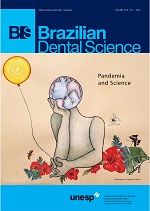Multidisciplinary approach for anatomical correction and diastema closure with laminates veneers – a clinical report
DOI:
https://doi.org/10.14295/bds.2020.v23i2.1817Abstract
Objective: multidisciplinary treatment has become increasingly common in dental offices and this treatment strategy is based on the achievement of a healthy, harmonious, and pleasant smile. In addition, the development of new ceramic systems and the possibility of making indirect restorations with a low thickness, such as laminates veneers, allowed combining highly satisfactory aesthetic properties, preserving the dental structure through minimal wear. Case report: this paper describes a multidisciplinary approach involving periodontics and restorative dentistry for the successful, functional, and aesthetic treatment in an adult patient. The digital smile design was performed as a guide to plan the clinical case considering factors such as tooth inclination and position, golden proportion, tooth size and shape. Discussion: based on these concepts, the present work reports, through a clinical case, the restoration of aesthetics and function with ceramic laminates veneers in lithium disilicate, in the case of anatomical correction and diastema closure. Conclusion: overall, the multidisciplinary treatment plan demonstrated to have greater advantages both for the aesthetics and function of the patient, as well as for the work team. During the 24-month follow-up, this case presented great functional and aesthetics results.
KEYWORDS
Ceramic veneers; Aesthetic dentistry; Multidisciplinary treatment.
Downloads
Downloads
Additional Files
Published
How to Cite
Issue
Section
License
Brazilian Dental Science uses the Creative Commons (CC-BY 4.0) license, thus preserving the integrity of articles in an open access environment. The journal allows the author to retain publishing rights without restrictions.
=================




























